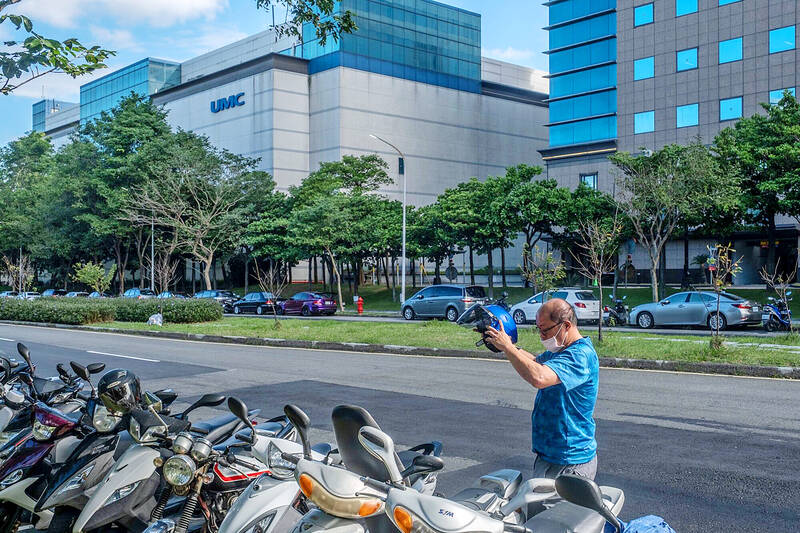Contract chipmaker United Microelectronics Corp (UMC, 聯電) yesterday reported that net profit last quarter declined 30.8 percent from a year earlier due to challenging macroeconomic conditions, a prolonged inventory correction and slow demand dragging down factory utilization.
Net profit plunged to NT$13.2 billion (US$421.7 million) last quarter, compared with NT$19.07 billion a year earlier. On a sequential basis, net profit contracted 17.4 percent from NT$15.97 billion, it said.
Earnings per share (EPS) dropped to NT$1.06 last quarter from NT$1.54 a year earlier and NT$1.29 the previous quarter.

Photo: Lam Yik Fei, Bloomberg
For the full year, net profit fell 30.2 percent to NT$61.44 billion from NT$88.02 billion in 2022, with EPS plunging to NT$4.93 from NT$7.09.
“Overall, 2023 was a year in which UMC demonstrated its resilience in the face of a challenging external environment, as an optimal product mix continued to lift blended average selling price by a mid-single-digit percentage year-on-year,” UMC copresident Jason Wang (王石) said during an investors’ conference.
Revenue last year shrank 10 percent to NT$222.53 billion, but the company expects it to pick up by 10 percent this year, in line with the foundry sector’s projected growth pace, but faster than the overall semiconductor industry’s growth of a mid-single-digit percentage, it said.
Still, its revenue projection is slower than the 20 to 25 percent growth forecast by its bigger rival, Taiwan Semiconductor Manufacturing Co (台積電).
Wang attributed the difference to a flattish addressable market.
“We are cautiously optimistic about this year,” he said. “The visibility is limited by macro uncertainty. Also, we are seeing lingering inventory issues for the automotive and industrial segments, although inventories at PC and mobile phone fronts have returned to healthy levels in the fourth quarter of 2023.”
The improvement in supply chain inventories has not translated into actual orders and revenue yet, as customers remain “cautious about restocking,” he said.
UMC expects wafer shipments this quarter to rise 2 to 3 percent sequentially, but factory utilization is likely to drop to the low-60 percent range from 66 percent last quarter, it said.
Gross margin is expected to fall to about 30 percent this quarter from 32.4 percent last quarter, the company said.
The blended average selling price is forecast to slip to 5 percent sequentially, but should hold steady for the rest of the year, it said.
Following its announcement last week that it was teaming up with Intel Corp to offer 12-nanometer chips from 2027, the company yesterday said it expects to see meaningful revenue contribution from this business that year.
The company expects to have process-design-kit ready for customers next year and to begin pilot production in 2026, Wang said.
UMC and Intel are to share the development costs for this project, he said.
The partnership with Intel comes as UMC aims to pursue cost-efficient capacity expansion and technology node advancement, Wang said.
The effort would broaden UMC’s addressable market and significantly accelerate its development roadmap, he said.
UMC has raised its projected capital expenditure to US$3.3 billion this year from US$3 billion, with a big chunk of the money going into 22-nanometer and 28-nanometer process technology capacity expansion.
It added that 28-nanometer technology was the biggest revenue contributor last quarter, accounting for 36 percent.

In a high-security Shenzhen laboratory, Chinese scientists have built what Washington has spent years trying to prevent: a prototype of a machine capable of producing the cutting-edge semiconductor chips that power artificial intelligence (AI), smartphones and weapons central to Western military dominance, Reuters has learned. Completed early this year and undergoing testing, the prototype fills nearly an entire factory floor. It was built by a team of former engineers from Dutch semiconductor giant ASML who reverse-engineered the company’s extreme ultraviolet lithography (EUV) machines, according to two people with knowledge of the project. EUV machines sit at the heart of a technological Cold

Taiwan’s long-term economic competitiveness will hinge not only on national champions like Taiwan Semiconductor Manufacturing Co. (TSMC, 台積電) but also on the widespread adoption of artificial intelligence (AI) and other emerging technologies, a US-based scholar has said. At a lecture in Taipei on Tuesday, Jeffrey Ding, assistant professor of political science at the George Washington University and author of "Technology and the Rise of Great Powers," argued that historical experience shows that general-purpose technologies (GPTs) — such as electricity, computers and now AI — shape long-term economic advantages through their diffusion across the broader economy. "What really matters is not who pioneers

Taiwan Semiconductor Manufacturing Co (TSMC, 台積電) last week recorded an increase in the number of shareholders to the highest in almost eight months, despite its share price falling 3.38 percent from the previous week, Taiwan Stock Exchange data released on Saturday showed. As of Friday, TSMC had 1.88 million shareholders, the most since the week of April 25 and an increase of 31,870 from the previous week, the data showed. The number of shareholders jumped despite a drop of NT$50 (US$1.59), or 3.38 percent, in TSMC’s share price from a week earlier to NT$1,430, as investors took profits from their earlier gains

TAIWAN VALUE CHAIN: Foxtron is to fully own Luxgen following the transaction and it plans to launch a new electric model, the Foxtron Bria, in Taiwan next year Yulon Motor Co (裕隆汽車) yesterday said that its board of directors approved the disposal of its electric vehicle (EV) unit, Luxgen Motor Co (納智捷汽車), to Foxtron Vehicle Technologies Co (鴻華先進) for NT$787.6 million (US$24.98 million). Foxtron, a half-half joint venture between Yulon affiliate Hua-Chuang Automobile Information Technical Center Co (華創車電) and Hon Hai Precision Industry Co (鴻海精密), expects to wrap up the deal in the first quarter of next year. Foxtron would fully own Luxgen following the transaction, including five car distributing companies, outlets and all employees. The deal is subject to the approval of the Fair Trade Commission, Foxtron said. “Foxtron will be